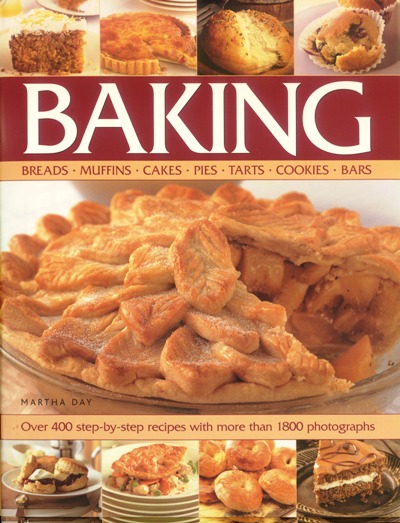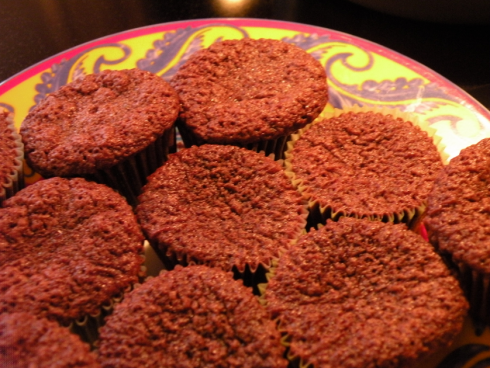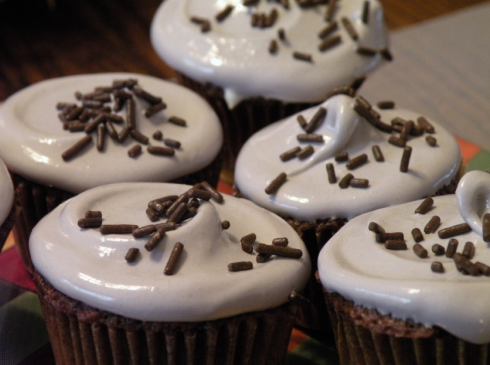A few days ago, I went shopping for flour, baking powder, and a few other baking essentials. Then I cracked open my brand-new baking book (“Baking” by Martha Day), and tried to decide which recipe should be Project Number One.
I picked up this book at my local Half Price Books, and I’m really pleased with it. It’s huge and has a stunning variety of recipes, both sweet and savory. It’s full of clear directions and helpful color photos, plus some introductory sections on baking tools and techniques for amateurs (like me!). The only teeny-weeny problem is that it’s, well, British–meaning it uses significantly different measurements, and sometimes different terminologies, than I’m used to. Although I kinda wish I’d noticed that before leaving the bookstore, I’m far too pleased with this book for every other reason to ever return it.
Confronted by so many glossy photos of pretty pastries, I found myself dreaming up elaborate pies, cakes, and tarts–but I knew those would have to wait for another day. I had to start with the basics! So I flipped through until I found a recipe for nice, simple chocolate cupcakes. What better place to start than with a no-fuss classic?
It’s a good thing I did start there…because as it turned out, even that simple recipe proved plenty challenging for me.
This particular recipe called for baking chocolate–not cocoa powder–which I’d never worked with before. The first step was to melt the chocolate with 1 tablespoon of water in a double boiler (or, in my case, in a bowl sitting on a simmering pot). Instead of melting into a nice, smooth chocolate sauce, my mixture kind of congealed. It became a bit lumpy and no amount of stirring seemed to make it any smoother. In desperation, I added a bit more water, which didn’t help in the slightest. After a little online research on melting chocolate, I read that mixing water into melted chocolate is exactly the wrong thing to do–and it seems that’s true! I’m confused, then, as to why the recipe says to mix the chocolate with water. Any thoughts?
After this hiccup, I soldiered on with the recipe and didn’t run into too many more problems. I slid my pan into the oven, set the timer, and waited, pleased with myself for having whipped up what looked like a decent batter.
A few minutes later, I peeked into the oven and found that one of my little cakes had oozed out of its cup, and the rest were rising somewhat messily. Does anyone know of a way to prevent cupcakes from oozing like that? When the timer finally went off and I pulled them all out, I was sad to see that they were a fairly ugly batch of cupcakes…kinda concave, rough on top, and marred with little air holes. I’m pretty sure the lumpy chocolate sauce is to blame for this, but if anyone has any other ideas, I’d love to hear them! I was feeling crummy about the whole endeavor until I pulled the ugliest, ooziest cupcake from the pan and bit into it–and fell in love! As ugly as it was, that cupcake was one of the tastiest I’d ever had. The cake was light and perfectly moist, and tasted great without any frosting at all.
…It’s a lucky thing, too, because the two batches of frosting I made proved even more abysmal than the cake! Here’s what happened:
I decided to go with the sugar icing recipe from my book, rather than a buttercream. And I just loathed the way it turned out–which I blame half on myself and half on the book. The worst thing about the icing was that it tasted way too lemony, so I’m not sure why the recipe called for 2 entire tablespoons of lemon juice. Still, it’s definitely my fault that the consistency was off–because I used the wrong sugar. Yes, ladies and gents, I used regular granulated sugar instead of powdered sugar. Who knew “icing sugar” meant “powdered sugar”? Probably everyone except me.
I didn’t realize this, though, until after I’d also made a batch of chocolate buttercream frosting. This went significantly better, until I realized that I had a soupy, grainy mess instead of a nice, spreadable frosting…and I finally looked up “icing sugar” and discovered my error. Of course, the only way to save the batch was to add the powdered sugar on top of the granulated sugar, so I ended up with doubly-sugary chocolate buttercream frosting. The stuff was completely delicious, but had the wrong texture and the effect of crack cocaine. Seriously, I felt my heart racing after just licking the spoon.
The next day, my brother ate four of the crack-cupcakes in a row, had a crazy sugar high, and then promptly crashed…making him the first innocent victim of my baking escapades.
I never got around to photographing my buttercream cupcakes, but here’s a pic of the sugar-icing ones (I kept the decoration quite simple, since I was pretty focused on the icing itself. I definitely regret not taking more time to make it a less noxious shade of lavender, though):
In the end, my cupcakes were definitely tastiest when eaten plain–assuming you could get over their ugly appearance. I’ll definitely be making this cake recipe again, because it really was one of the yummiest cakes I’ve ever had…but I’ll try very hard next time to melt my chocolate right and avoid those lumps and bumps!
THE RECIPE:
4 oz good-quality plain chocolate, cut into small pieces
1 tablespoon water
10 oz plain flour
1 teaspoon baking powder
1/2 teaspoon bicarbonate of soda
pinch of salt
10 oz caster sugar
6 oz butter or margarine, at room temperature
1/4 pint milk
1 teaspoon vanilla essence
3 eggs
1 Preheat a 350° oven. Grease or line 24 cups.
2 Put the chocolate and water in a bowl set over a pan of almost simmering water. Heat until melted and smooth, stirring. Remove from heat and leave to cool.
3 Sift the flour, baking powder, bicarbonate of soda, salt and sugar into a large bowl. Add the chocolate mixture, butter, milk and vanilla essence.
4 With an electric mixer on medium-low speed, beat until smoothly blended. Increase the speed to high and beat for 2 minutes. Add the eggs and beat for 2 minutes.
5 Divide the mixture evenly among the prepared tins.
6 Bake for 20-25 minutes or until a skewer inserted into the centre of a cake comes out clean. Cool in the tins for 10 minutes, then turn out to cool completely on a wire rack.
Sugar Icing:
2 egg whites
12 oz caster sugar
2 tbsp cold water
2 tbsp fresh lemon juice
1/4 tsp cream of tartar
food colouring
Combine the egg whites, caster sugar, water, lemon juice and cream of tartar in the top of a double boiler or in a bowl set over simmering water. With an electric mixer, beat until thick and holding soft peaks, about 7 minutes. Remove from the heat and continue beating until the mixture is thick enough to spread. Tint the icing with food colouring.
Buttercream Frosting:
4 oz butter, preferably unsalted, at room temperature
8 oz icing sugar, sifted
1 teaspoon vanilla essence
about 2 teaspoons milk
1 Put the butter in a deep mixing bowl and beat it with an electric mixer at medium speed until it is soft and pliable.
2 Gradually add the icing sugar and beat at medium-high speed. Continue beating until the mixture is pale and fluffy.
3 Add the vanilla essence and 1 tablespoon milk. Beat until smooth and of a spreading consistency. If it is too thick, beat in more milk. If too thin, beat in more sugar.




Leigh,
Check out Rose Levy Beranbaum’s book, Cake Bible. You should be able to find it at the library. Step by step directions that are no fail–she is awesome! And all the measurements are “in American” ;o)
Thanks so much! I’ll look for it. Sounds very promising for someone like me. :)